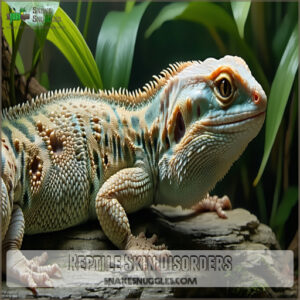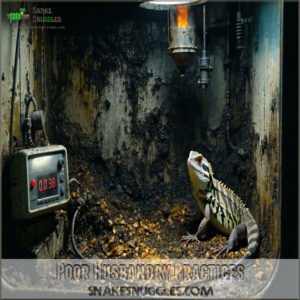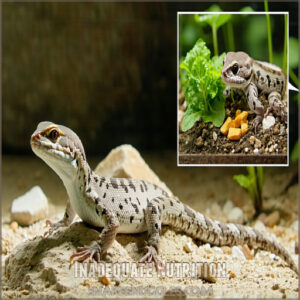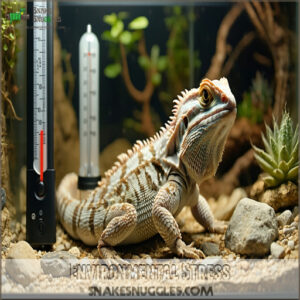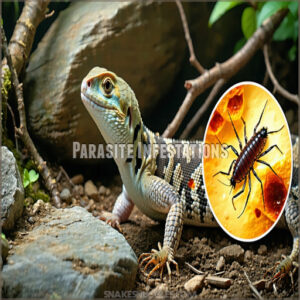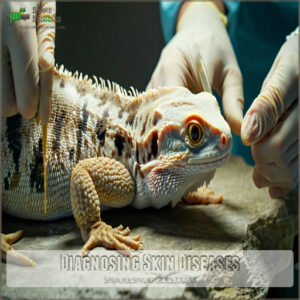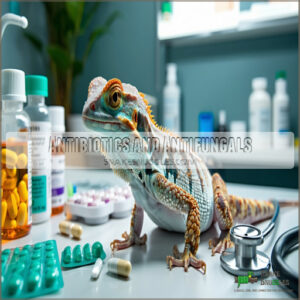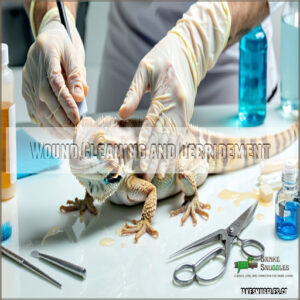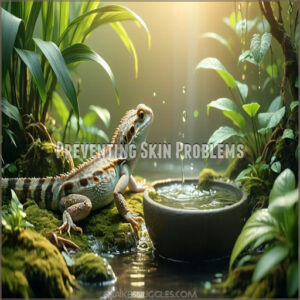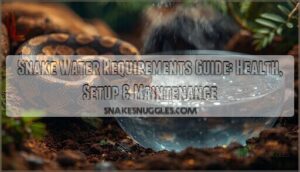This site is supported by our readers. We may earn a commission, at no cost to you, if you purchase through links.
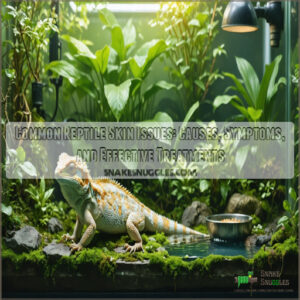
Watch for bacterial infections like dermatitis, which causes discoloration, swelling, and bad odors, or fungal infections that show up as crusty lesions and thrive in poor humidity.
Parasites like mites and ticks can cause irritation and skin damage, while abscesses appear as firm, pus-filled lumps.
Shedding problems, or dysecdysis, often stem from low humidity and stress.
To keep these issues at bay, focus on clean habitats, proper nutrition, and consistent temperature and humidity.
Curious about treatment strategies? Keep reading!
Table Of Contents
- Key Takeaways
- Reptile Skin Disorders
- Causes of Skin Issues
- Diagnosing Skin Diseases
- Treating Reptile Skin Issues
- Preventing Skin Problems
- Frequently Asked Questions (FAQs)
- Do reptiles have scaly skin?
- What factors affect a reptile’s health?
- How do you know if a reptile has an infection?
- Why do reptiles have sores?
- How do you get rid of skin on a reptile?
- What is the skin disorder that looks like reptile skin?
- What rash looks like reptile skin?
- What are the symptoms of adenovirus in reptiles?
- What is the skin disease in lizards?
- How do humidity changes affect reptile shedding?
- Conclusion
Key Takeaways
- Keep your reptile’s habitat clean and maintain proper temperature and humidity to prevent infections and shedding problems.
- Watch for symptoms like discoloration, crusty patches, or unusual shedding to catch and address skin issues early.
- Provide a balanced diet with essential vitamins and clean water to promote healthy skin and prevent nutritional deficiencies.
- Handle your reptile gently and regularly check for parasites, sores, or wounds to ensure their well-being.
Reptile Skin Disorders
Reptile skin disorders can show up as infections, shedding problems, or strange patches on their scales, often caused by poor care or parasites.
Understanding these issues helps you treat them early and keep your reptile healthy.
Reptile owners should be aware that these skin disorders are often a result of poor care.
Bacterial Dermatitis
Bacterial dermatitis in reptiles often starts with small skin lesions from wounds or poor husbandry.
Symptoms like discoloration, swelling, and unusual odors signal bacterial skin infections.
Left untreated, they worsen quickly, and it is crucial to clean wounds promptly to prevent reptile bacterial infections, and seek veterinary care for antibiotics.
Proper hygiene and habitat management are critical for avoiding bacterial skin infections and keeping your reptile healthy.
Regular monitoring of reptile skin health can help identify potential issues before they become severe, ensuring the overall health of your reptile.
Fungal Dermatitis
Fungal infections in reptiles can sneak up on you, starting with crusty skin lesions or odd yellow patches (hello, fungal spores!).
If untreated, these fungal dermatitis signs worsen, leading to deeper tissue damage.
Reptile fungus thrives in poor conditions, so snug humidity levels help.
Dermatitis treatment? Think topical care, antifungal treatments like itraconazole, and UV exposure for fungus-busting.
Understanding reptile mycotic diseases is essential for effective prevention and treatment of these infections.
Abscesses
Reptile abscesses can sneak up on you, starting as firm skin lumps filled with pus from bacterial infections.
Poor hygiene or injuries often pave the way for these skin lesions.
Abscess treatment includes careful wound care, draining the abscess, and antibiotics for infection control.
Keeping enclosures clean and spotting these reptile skin issues early helps tackle bacterial dermatitis effectively.
Mites and Ticks
Mites and ticks are pesky parasites that irritate your reptile’s skin and can spread infections.
Here’s how to handle them:
- Spot the signs: Itchy, restless behavior or black/red specks on scales.
- Mite removal: Use reptile-safe sprays or diluted betadine baths.
- Tick prevention: Carefully remove ticks with tweezers.
- Reptile hygiene: Clean enclosures weekly for effective ectoparasite management.
The instructions provided are designed to help manage and prevent mites and ticks on reptiles, emphasizing the importance of reptile hygiene and proper mite removal and tick prevention techniques.
Dysecdysis
Shedding issues—like stuck shed or retained scales—are called reptile dysecdysis.
It’s often caused by low humidity or poor care.
Watch for scale damage, skin lesions, or ecdysis problems.
Gently soaking your reptile can loosen retained scales, but never force them off!
Keep their habitat humid and clean to avoid shedding difficulties, helping your buddy shed like a pro.
Causes of Skin Issues
Skin issues in reptiles often start with things you can control, like enclosure hygiene, diet, and habitat conditions.
When these areas aren’t managed properly, parasites and stress can quickly add to the problem.
Poor Husbandry Practices
Improper reptile care often invites skin problems.
Poor husbandry damages their health, like living in dirty, unsuitable enclosures or battling wild temperature swings.
To prevent issues, watch these key factors:
- Enclosure Maintenance: Clean regularly to avoid bacteria buildup.
- Temperature Control: Stay in the ideal range for your species.
- Humidity Management: Combat shedding troubles.
- Substrate Quality: Skip harmful materials like cedar shavings.
Inadequate Nutrition
Feeding errors, like skipping variety or ignoring supplements, can trigger malnutrition in reptiles.
Nutritional disorders, such as vitamin deficiencies, stunt skin health—think cloudy eyes or dull scales.
Vitamin A imbalances irritate skin cells, while nutrient imbalance leads to shedding troubles.
Avoid dietary mistakes by offering balanced meals, matching their wild diet, to ensure proper nutrition.
A well-planned snake diet plan is essential for maintaining healthy skin in reptiles.
Environmental Stress
Environmental stress throws your reptile’s world into chaos.
Here’s how:
- Temperature fluctuations: Too hot or cold? That messes up digestion and immune health.
- Reptile humidity problems: Low moisture can lead to shedding issues, while too much promotes infections.
- Lighting effects: Incorrect UVB exposure weakens bones or triggers stress.
Stay on top of habitat conditions for a happier, healthier reptile.
Parasite Infestations
Parasites like mites and ticks aren’t just annoying—they can wreak havoc on your reptile’s skin if left unchecked.
Ectoparasite management includes regular habitat cleaning and inspections.
Use proper mite removal techniques and focus on tick prevention by keeping enclosures secure.
For infestation treatment, consult your vet for safe options.
Controlling reptile parasites protects health and keeps skin issues at bay.
Diagnosing Skin Diseases
If your reptile’s skin looks off, spotting the issue early is essential to their health.
You’ll need to check for subtle signs like discoloration, odd odors, or unusual shedding.
Sometimes even involve tests like microbial cultures or parasite checks.
Recognizing Early Warning Signs
Spotting early warning signs of reptile skin problems can save your pet from long-term issues.
Look for skin lesions, odd discoloration signs, or unusual shedding issues.
Watch for behavioral changes like lethargy or loss of appetite.
Foul odors or crusty patches? That’s a red flag.
Learning these warning symptoms keeps their reptile skin health in check and avoids common skin disorders spiraling out of control.
Microbial Cultures
You’ve spotted troubling signs—discoloration or odd textures—and now it’s time for microbe testing.
This process involves microbial cultures that help pinpoint bacterial or fungal infections like bacterial dermatitis.
A vet collects samples from lesions or skin swabs for lab analysis, and these culture results identify culprits, guiding targeted treatments like antibiotics or antifungals.
Think of it as detective work for reptile skin diseases.
Parasite Identification
You’ve noticed odd movements on your reptile’s skin? Time for parasite detection. Common ectoparasites, like mites and ticks, can cause irritation and infection.
To spot them, you should follow these steps:
- Check under scales and folds.
- Use a magnifying glass for tiny mites.
- Examine shedding debris for live pests.
- Look for skin irritation signs.
If you find any signs of infestation, it is crucial to take immediate action, especially for severe infestations or mite removal, and consult a vet.
X-rays and Blood Tests
Sometimes, solving reptile skin problems requires digging deeper—literally.
Diagnostic imaging like X-rays or CT scans helps spot hidden injuries or infections beneath the surface.
Meanwhile, blood work reveals systemic issues, like infections or nutrient imbalances.
These medical tests may sound intense, but they’re quick, accurate, and key for treatment.
Trust your vet’s expertise—accurate laboratory results mean fewer guessing games.
Treating Reptile Skin Issues
When treating reptile skin issues, you’ll need to address both the underlying cause and the symptoms to help your pet heal effectively.
From antibiotics to environmental changes, these practical steps can make all the difference in improving their health.
Antibiotics and Antifungals
When reptile skin problems strike, antimicrobial therapy becomes essential.
For bacterial infections, antibiotics like topical ointments or prescribed oral medications tackle reptile bacterial diseases effectively.
Treat fungal infections with antifungal medications after cleaning the area.
Avoid medication resistance by strictly following veterinary guidance.
Whether it’s bacterial treatment or antifungals, quick action keeps your scaly friend looking sharp and feeling healthy.
Reptile owners can find suitable reptile antibiotics to address various skin issues under veterinary supervision.
Wound Cleaning and Debridement
After treating infections, wound cleaning keeps bacteria at bay and speeds up tissue repair.
Use warm saline or antiseptics to gently cleanse reptile wounds.
For stubborn debris, skilled debridement techniques remove dead tissue, promoting healthy growth.
Avoid harsh chemicals—they harm delicate scales.
If deep wounds persist, veterinary care, like surgical interventions, guarantees proper wound healing.
Safe, consistent wound management prevents lingering reptile skin problems.
Effective wound cleaning products are essential for promoting healthy tissue growth and preventing infection in reptiles.
Environmental Adjustments
Dialing in your reptile’s environment helps prevent skin issues and boosts healing.
Focus on these essentials:
- Temperature control: Keep ranges species-specific to avoid environmental stress.
- Humidity management: Too much or too little can cause shedding problems or infections.
- Lighting systems and airflow: UVB lights and good air circulation maintain healthy skin while reducing infections.
A clean, balanced setup keeps problems in check!
Nutritional Support and Hydration
A healthy reptile diet isn’t just lettuce and crickets—it’s science.
Focus on a balanced diet to avoid nutritional disorders. Add vitamin supplements and monitor mineral intake for steady growth.
Hydration’s key too: clean water daily guarantees no vitamin deficiencies. If shedding looks off, try electrolyte management.
Nail good water quality, and your reptile’s skin will thrive!
Effective reptile skin infection treatment also relies on a combination of proper hygiene and nutrition to prevent infections.
Preventing Skin Problems
You can prevent most reptile skin problems by keeping their habitat clean, maintaining proper temperature and humidity, and offering a balanced diet.
Regular health checks and gentle handling also go a long way in keeping their skin healthy and stress-free.
Maintaining Clean Living Conditions
Keeping your reptile’s home clean isn’t just a chore—it’s the backbone of their health.
Regular cleaning schedules, like spot-cleaning daily and deep-cleaning monthly, promote superior enclosure hygiene.
Choose substrates that are easy to clean and avoid trapping bacteria.
Pair this with proper temperature management and humidity control to keep the space healthy.
A clean habitat prevents stress and skin issues.
Using a reptile terrarium cleaner is essential for maintaining a healthy environment and preventing the buildup of harmful bacteria and germs.
Proper Nutrition and Hydration
A balanced diet isn’t just about feeding schedules – it’s the secret sauce for reptile nutrition.
Combine live prey, low-oxalate veggies, and dietary supplements to dodge vitamin deficiencies.
Dehydration? Not on your watch.
Fresh water and smart hydration techniques keep skin healthy.
Good nutrient balance and high-quality water quality guarantee your reptile thrives, not just survives, with a proper balanced diet.
Monitoring Habitat Conditions
Think of your reptile’s enclosure as their little world—it needs to mimic nature.
Temperature control and humidity management are non-negotiable, so keep those stable to prevent environmental stress.
Check that lighting systems provide proper UVB, and keep surfaces clean.
Watch for air quality and regular water cycling; poor conditions can lead to serious reptile enclosure issues down the road.
Regular Health Checks and Gentle Handling
Checking your reptile regularly isn’t just smart—it’s how you catch problems early.
Use these Reptile Handling Tips:
- Look for skin discoloration, parasites, or injuries.
- Gently handle to avoid stress—never grab from above.
- Develop Health Check Schedules to maintain consistency.
- Learn Gentle Care Methods through research or vet advice.
These small steps prevent reptile stress reduction while boosting reptile skin health.
Proper snake skin care is essential for maintaining healthy scales and preventing infections.
Frequently Asked Questions (FAQs)
Do reptiles have scaly skin?
Yes, reptiles have scaly skin made of keratin, giving them armor-like protection.
These scales help with moisture retention and defense.
Ever noticed how cool snakes or lizards look? That’s all thanks to their unique scales!
What factors affect a reptile’s health?
A reptile’s health rests on a delicate balance of proper temperature, clean habitats, nutrition, hydration, and low stress.
Poor husbandry, parasite infestations, or neglecting environmental needs can quickly throw everything out of sync, causing issues.
How do you know if a reptile has an infection?
Watch for unusual discoloration, foul-smelling drainage, lethargy, or appetite loss.
Blisters, swelling, crusty patches, or excessive shedding can also signal infection.
Quick vet care and habitat adjustments can prevent it from spiraling into worse problems.
Why do reptiles have sores?
Ever noticed a sore on your reptile and wondered why?
It could stem from poor habitat hygiene, improper humidity, or injuries.
Even parasites or bad nutrition play a part.
Addressing care fixes most issues!
How do you get rid of skin on a reptile?
Gently remove stuck skin by soaking your reptile in lukewarm water for about 20 minutes.
Use a soft, damp cloth or tweezers to help loosen stubborn pieces, but never pull forcefully—patience is key!
What is the skin disorder that looks like reptile skin?
When your skin resembles reptile scales, it’s often linked to "ichthyosis vulgaris".
This condition causes dry, cracked skin, like fish scales, due to improper shedding of dead skin cells.
Hydration and exfoliation usually help.
What rash looks like reptile skin?
A rash resembling reptile skin often appears as dry, scaly patches, commonly linked to eczema, psoriasis, or ichthyosis.
These conditions can cause your skin to thicken, crack, and peel, mimicking the texture of reptile scales.
What are the symptoms of adenovirus in reptiles?
What tips you off that something’s wrong?
Adenovirus symptoms in reptiles include lethargy, appetite loss, weight loss, diarrhea, neurological issues like tremors, and respiratory distress.
It’s often tricky to spot, so early vet care makes all the difference, especially in addressing adenovirus symptoms.
What is the skin disease in lizards?
Lizards can face skin problems like bacterial infections, fungal dermatitis, mites, and shedding issues.
You’ll spot discoloration, sores, or unusual shedding.
Keeping their habitat clean, moist, and well-lit prevents many issues before they begin, including bacterial infections and skin problems.
How do humidity changes affect reptile shedding?
Imagine a stuck zipper—that’s what shedding feels like when humidity’s off.
Too low, and their skin sticks; too high, and infections thrive.
Balance humidity carefully to keep shedding smooth and your reptile healthy.
Conclusion
Addressing common reptile skin issues starts with understanding their root causes and acting fast.
Poor husbandry and environmental stressors often set the stage for these problems, but they’re preventable with proper care.
Keep habitats clean, maintain correct temperature and humidity, and watch for early symptoms like discoloration or swelling.
If your reptile shows signs of trouble, consult a vet to guide treatment.
With attentive care and prevention, your scaly companion can stay healthy and thrive.

